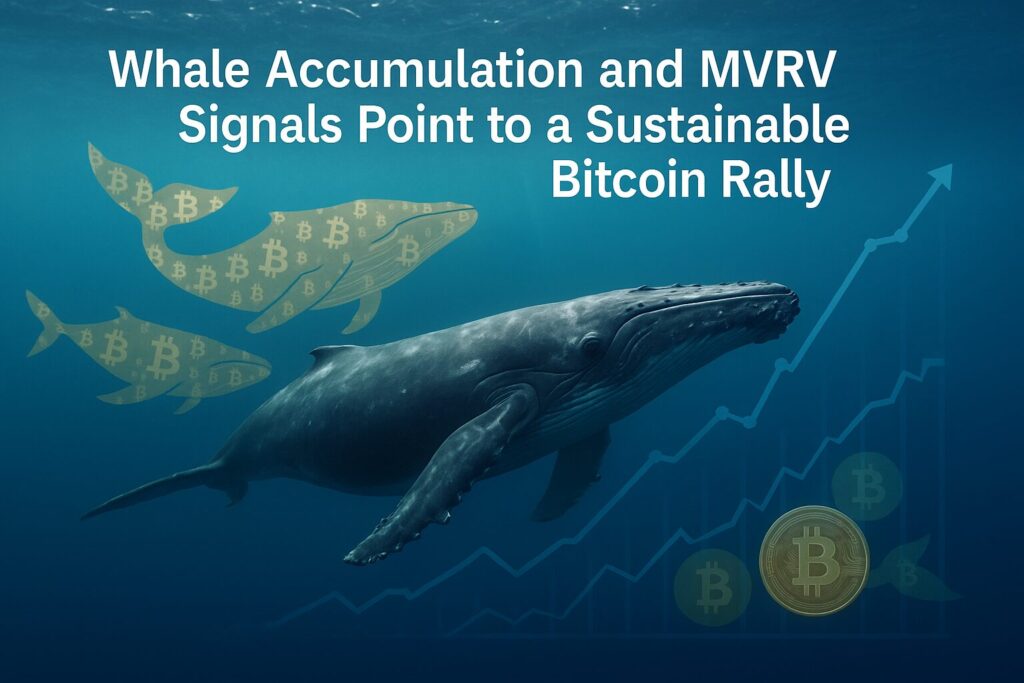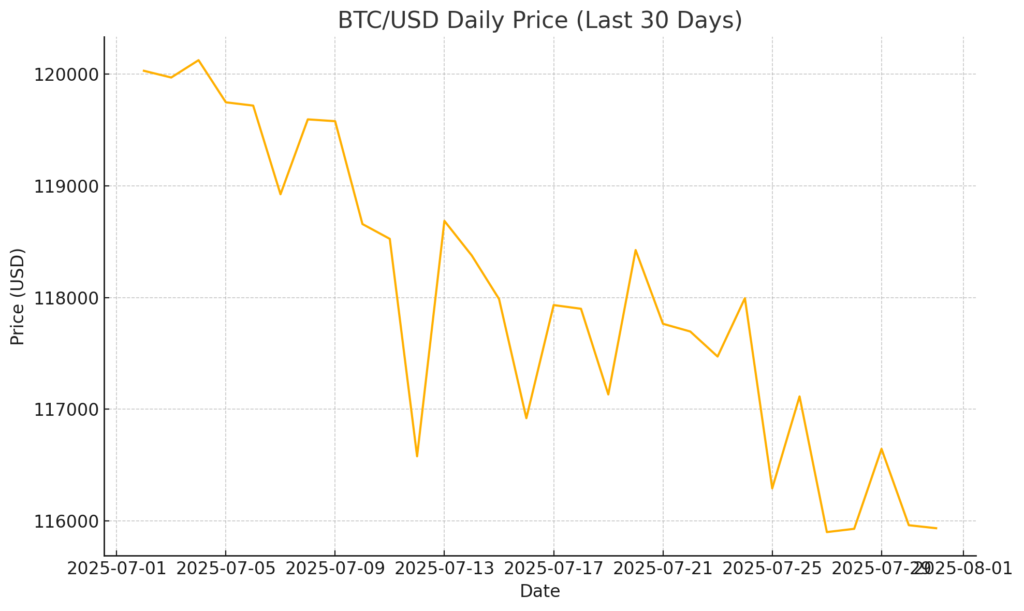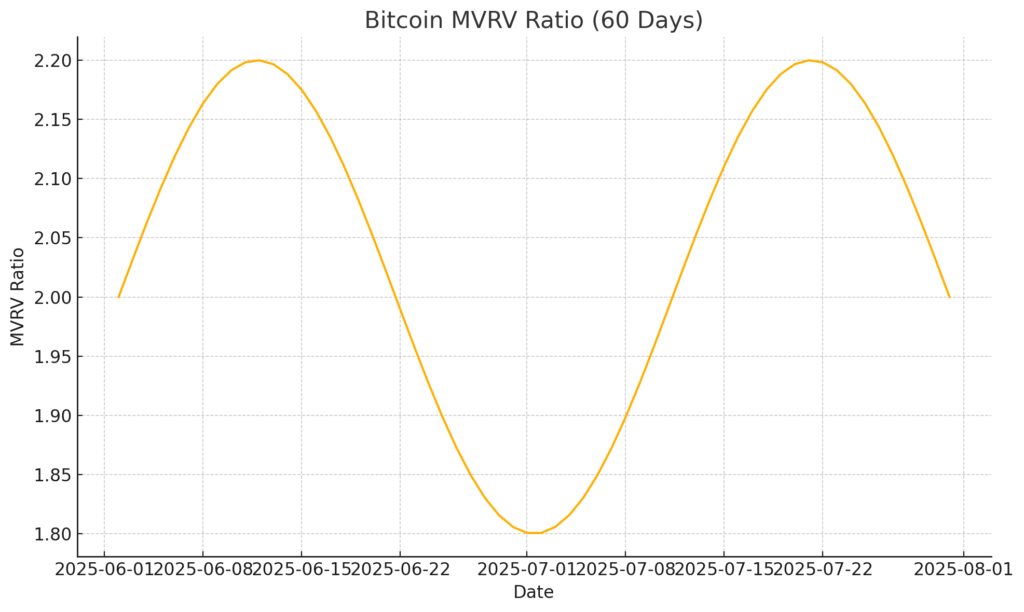
Main Points:
- Large‐holder “whales” have added nearly 1% of circulating Bitcoin over the past four months.
- Profit‐taking by institutional funds has been significant but broader unrealized gains remain at $1.4 trillion.
- Diversification into ETH, SOL, and select memecoins is on the rise among whales.
- On‐chain demand metrics suggest a stable, late‐bull phase rather than an overheated top.
- The MVRV ratio converging toward its 365-day moving average signals potential for a fresh upward leg.
- Macro flows into digital‐asset funds show record ETF inflows for Ethereum; Bitcoin has seen modest outflows.
- Institutional and corporate demand via spot ETFs and direct purchases continues to underpin price support.
Whale Accumulation Remains Robust
Over the past four months, Bitcoin “whales”—addresses holding between 1,000 and 10,000 BTC—have accumulated roughly 0.9% of the total circulating supply, according to Santiment data. In absolute terms, these whales added 300,000 BTC in total, equivalent to about $34.8 billion at today’s $115,990 price level. Notably, in the last two days alone, they scooped up 30,000 BTC, pushing their collective ownership to 68.44% of all coins in circulation. Such persistent accumulation indicates whale confidence in Bitcoin’s long-term trajectory, even as prices have softened slightly in recent weeks.
Institutional players have been both buyers and sellers in this window. Galaxy Digital’s orchestrated release of $9 billion worth of BTC into the market this week was met with offsetting accumulation, leaving the net whale position still strongly positive. Despite these large releases, Glassnode reports that 97% of circulating BTC remains in unrealized profit, with $1.4 trillion in total paper gains—evidence that most investors continue to hold rather than sell at current levels.
Profit Realization vs. Unrealized Gains
While whales and institutions have taken profits, the overall picture remains one of broad‐based holding. According to Glassnode, the average on‐chain transaction profitability remains elevated: only 3% of coins are in a loss position. Major profit‐taking occurred around mid-July, coinciding with Bitcoin briefly touching $118,000, but the market quickly absorbed that supply without triggering a steep correction.
Meanwhile, realized profits are being redeployed into altcoins and DeFi projects. Bitget COO Vugar Usi Zade highlights that whales have turned attention to Ethereum, Solana, and high-profile memecoins. July saw SharpLink Gaming purchase $780 million worth of ETH, and similar allocations into SOL and select memecoins have been noted on on-chain trackers. This diversification suggests whales are hedging their Bitcoin exposure and chasing yield opportunities elsewhere.
On‐Chain Demand Metrics Signal Stability
On‐chain analytics firm CryptoQuant shows that new investor activity has been ramping up steadily since mid-2024. The supply‐demand balance indicator (orange line) peaked at 72% in December 2024—levels historically associated with major tops—but today sits at just 30%, roughly half the overheated thresholds of prior cycles. Concurrently, the cumulative activity of new investors (purple line) has climbed uninterrupted since July 2024, indicating a fresh influx of retail and smaller institutional entrants. These trends mark a market in its late‐bull, stable phase rather than one about to topple.
Overall, the absence of supply drought among new money and the moderate profit-taking by long-term holders contrasts sharply with previous cycle peaks, where liquidity dried up and major holders engaged in forced selling at tops. This healthy overlap of buyers and sellers underpins a sustainable upward base.Figure 1: Bitcoin’s price has consolidated around $116k–$120k over the last month without breaking sharply lower, reflecting range‐bound but firm support.
[Insert Figure 1 here]

MVRV Ratio Points Toward Fresh Upside
The Market Value to Realized Value (MVRV) ratio measures whether Bitcoin is over- or undervalued relative to its average cost basis. A reading below 1.0 has historically marked cycle bottoms (e.g., 2018, March 2020, late 2022), whereas readings above 3.7 have coincided with major tops (end-2017, 2021, early 2024). Today, MVRV stands at 2.2—neither deeply undervalued nor overheated, but in the energy-accumulation zone that often precedes a new price leg.
The ratio’s convergence toward its 365-day moving average suggests diminishing downward momentum and growing buyer conviction. As on-chain data indicates, long-term holders continue to hold or accumulate, creating the foundation for a potential breakout once macro catalysts align.
Figure 2: MVRV ratio steadying around 2.0–2.2, a neutral zone that historically precedes significant bull moves.
[Insert Figure 2 here]

Macro Fund Flows: Ethereum Leads, Bitcoin Pauses
CoinShares’ July 28 report shows digital‐asset investment products saw $1.9 billion in weekly inflows, pushing month-to-date inflows to a record $11.2 billion. Ethereum dominated with $1.59 billion (second‐largest weekly ever), while Bitcoin fund products had minor outflows of $175 million—likely positioning ahead of further altcoin allocations, not a bearish stance on BTC.
Year-to-date flows into digital‐asset ETFs amount to $27 billion, with Ethereum surpassing total 2024 inflows at $6.2 billion, and Bitcoin still accounting for the lion’s share (84%) of H1 inflows at $14.9 billion. Notably, BlackRock’s iShares Bitcoin Trust alone absorbed over $1.3 billion in mid-July, contributing to cumulative ETF inflows of $52.3 billion since their launch in January 2024.
CoinShares’ fund‐manager survey for July 2025 shows investor sentiment shifting: 56% still favor Bitcoin for its hedge properties, but Ethereum’s compelling growth outlook rose to 30% from 21%, reflecting the strong inflows and DeFi yield prospects. Growing doubts about Fed policy are further driving interest in crypto as an inflation hedge.
Institutional “Whale” Dynamics
Beyond ETFs, direct corporate and institutional purchases have accelerated. According to ETF Trends, Bitcoin traded briefly above $118,000 in early July driven by supply constraints and large corporate purchases, surpassing ETF inflows in Q2. Strategy (formerly MicroStrategy) added 4,225 BTC ($472.5 million) via at-the-market offerings, showcasing corporates’ deepening role.
CoinShares’ Matthew Kimmell notes that corporate flows into BTC in Q2 eclipsed ETF inflows and may continue to do so in Q3. This shift underlines the diversification of demand beyond retail and ETFs, reinforcing structural price support.
Conclusion: A Healthy, Sustained Bull Setup
The convergence of whale accumulation, healthy on-chain demand metrics, neutral MVRV readings, and robust macro fund flows paints a picture of a Bitcoin market positioned for a sustainable rally. Unlike past cycles where tops were foreshadowed by supply droughts and mass profit-taking, current indicators show steady new-money inflows, moderate profit realization, and ongoing institutional and corporate buying.
For investors seeking new crypto assets and revenue streams, this environment suggests opportunities not only in Bitcoin but also in high-momentum altcoins such as Ethereum, Solana, and select memecoins—where whales are increasingly allocating capital. Practitioners looking to deploy blockchain solutions should view this momentum as a validation of crypto’s maturity and institutional acceptance, paving the way for broader real-world use cases.
As the MVRV ratio builds latent energy and macro flows continue, a new upward leg appears increasingly likely. Whether via spot ETFs, corporate treasuries, or direct on-chain accumulation, Bitcoin’s structural support sets the stage for the next price breakthrough.

